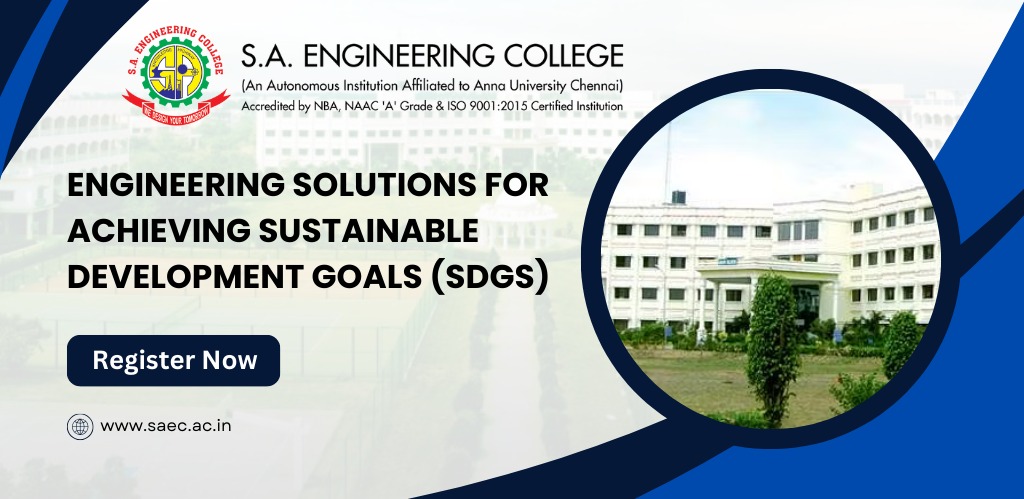
Engineering Solutions for Achieving Sustainable Development Goals (SDGs)
- Posted by Praveenkumar S
- Categories Engineering Solutions
- Date March 1, 2025
The Sustainable Development Goals (SDGs), are a roadmap for achieving a sustainable future by addressing global issues such as poverty, inequality, environmental degradation, and climate change. These goals are a call to action for all sectors, and engineering plays a crucial role in developing innovative, practical, and scalable solutions to meet these objectives.
This blog delves deeper into how engineering solutions are integral to achieving the SDGs, highlighting the opportunities, challenges, and success stories across various sectors.
A Closer Look at Sustainable Development Goals
The SDGs aim to balance economic, social, and environmental sustainability by 2030. Each goal aligns with specific challenges that engineers can tackle through cutting-edge technology, innovative designs, and efficient resource utilization. Some of the critical SDGs where engineering has a profound impact include:
No Poverty
Engineering contributes by creating affordable housing, developing infrastructure, and generating renewable energy to improve livelihoods.
Clean Water and Sanitation
Engineers design water purification systems, sewage treatment plants, and rainwater harvesting mechanisms to ensure access to clean water.
Affordable and Clean Energy
Engineering innovations in renewable energy sources like solar, wind, and hydropower are crucial for achieving energy security.
Industry, Innovation, and Infrastructure
Resilient infrastructure, sustainable industrialization, and innovative technologies are at the core of this goal.
Climate Action
Engineers address climate change through carbon capture, renewable energy, and climate-resilient infrastructure.
The Role of Engineering in Achieving SDGs
- Clean Water and Sanitation
Access to clean water and sanitation is a fundamental human right. Engineers address this by developing innovative water treatment solutions, desalination plants, and advanced irrigation systems. Smart water management using IoT and AI ensures the efficient use of resources.
Example: Engineers in India have implemented solar-powered water purification systems in rural areas, providing safe drinking water while reducing dependency on fossil fuels.
- Affordable and Clean Energy
- Industry, Innovation, and Infrastructure
This goal emphasizes building resilient infrastructure and fostering innovation. Engineers play a vital role in developing sustainable transportation systems, such as electric vehicles (EVs), bullet trains, and smart roadways. Industry 4.0 technologies, including IoT, robotics, and automation, optimize production and reduce waste.
Example: The use of 3D printing in construction reduces material waste and speeds up the development of affordable housing projects.
- Sustainable Cities and Communities
Urbanization has posed challenges in housing, transportation, and waste management. Civil engineers and urban planners create smart cities integrating renewable energy, green spaces, and efficient waste management systems.
Example: Singapore’s Marina Barrage, a water reservoir and recreational area, demonstrates how engineering solutions can balance urban needs with sustainability.
- Climate Action
Climate change is one of the most pressing global challenges. Environmental engineers are innovating solutions such as carbon capture technologies, green infrastructure, and renewable energy systems to combat climate change.
Example: Denmark’s offshore wind farms have become a global model for reducing carbon footprints and generating clean energy.
Emerging Technologies and Their Impact
Artificial Intelligence (AI) and Machine Learning (ML)
AI optimizes resource allocation, predicts trends, and provides data-driven solutions for various SDGs. For example, AI-powered systems can predict energy consumption and optimize renewable energy production.
Internet of Things (IoT)
IoT devices monitor real-time data on air quality, water levels, and energy consumption, enabling quick and efficient decision-making. Smart grids and precision agriculture are key IoT applications supporting sustainable goals.
Blockchain Technology
Blockchain ensures transparency and efficiency in supply chains, contributing to SDGs like Responsible Consumption and Production (Goal 12). For instance, blockchain can track the lifecycle of materials in a circular economy.
3D Printing and Advanced Manufacturing
These technologies reduce material waste, promote customization, and enable sustainable construction and manufacturing practices.
Challenges in Implementing Engineering Solutions
Despite significant progress, several challenges hinder engineering efforts in achieving the SDGs:
Resource Constraints
Limited access to financial, material, and human resources slows the implementation of sustainable solutions.
Policy Barriers
Inconsistent policies and regulatory frameworks across regions create obstacles for adopting innovative technologies.
Technical Skill Gaps
A lack of skilled professionals in emerging technologies hampers progress in addressing complex problems.
Resistance to Change
Communities and industries often resist transitioning to sustainable practices due to perceived costs and inconveniences.
Case Studies: Engineering Driving Change
- Solar-Powered Desalination in Chile
Chile has pioneered solar-powered desalination plants to address water scarcity in arid regions, achieving SDGs (Clean Water) and (Clean Energy).
- Green Infrastructure in Europe
The European Green Deal has fostered the development of sustainable infrastructure projects, including energy-efficient buildings and eco-friendly transportation systems, aligning with Goals.
- Biodegradable Plastics in India
Indian engineers have developed biodegradable plastics using agricultural waste, reducing environmental pollution and supporting SDG.
Future Directions in Engineering for Sustainability
Integrating Sustainability in Education
Engineering curricula must incorporate sustainability principles to prepare the next generation of engineers for global challenges.
Global Collaboration
Partnerships among governments, industries, and academia can accelerate the adoption of sustainable engineering practices.
Investment in Research and Development
Increased funding for innovative technologies will enable scalable solutions to address SDGs.
Adopting Circular Economy Principles
Designing products and systems with a focus on reuse, recycling, and waste reduction will significantly contribute to sustainability.
Conclusion
Engineering holds the key to achieving the Sustainable Development Goals by addressing challenges with innovative and practical solutions. From clean water and energy to climate action and sustainable infrastructure, engineers are driving transformative change globally. However, realizing the full potential of engineering in sustainability requires collective effort, investment, and a commitment to continuous innovation.
By leveraging technology and collaboration, we can build a sustainable future where economic growth, environmental preservation, and social equity coexist harmoniously. Engineers are not just problem-solvers; they are the architects of a sustainable tomorrow.
